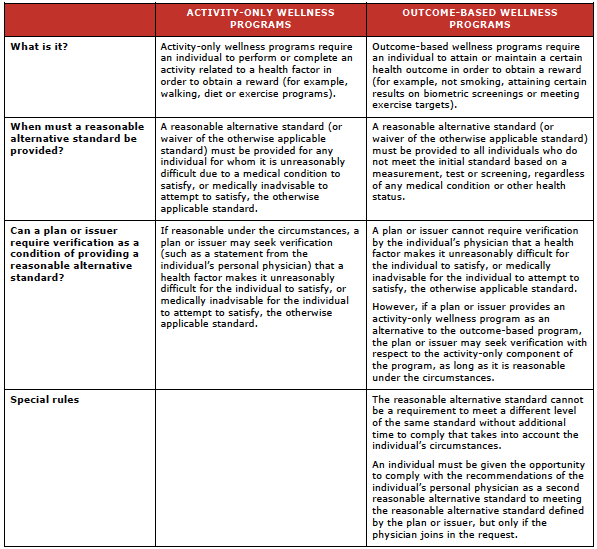Final ACA Regulations on Workplace Wellness Programs Released
By The Bailey Group Staff
Published May 30, 2013

On May 29, 2013, the Department of Labor, Health and Human Services and the Treasury released final regulations that implement ACA’s nondiscrimination requirements for wellness programs.
The final regulations clarify and reorganize the rules outlined in previous proposed regulations. They are intended to ensure that every individual participating in a wellness program can receive the full amount of any reward or incentive, regardless of any health factor.
The Affordable Care Act (ACA) includes provisions to encourage the use of wellness programs related to group health coverage. Effective for plan years beginning on or after Jan. 1, 2014, ACA adopts the existing HIPAA nondiscrimination requirements for health-contingent wellness programs, while also increasing the maximum reward that can be offered under these programs.
Specifically, the final regulations:
- Formally adopt the proposed nondiscrimination rules for health-contingent wellness programs, such as giving individuals an opportunity to qualify for the reward each year and providing an alternative standard or waiver for individuals with health conditions;
- Divide health-contingent wellness programs into two categories: activity-only wellness programs and outcome-based wellness programs; and
- Increase the permissible reward for meeting a health-related standard to 30 percent of the total cost of employee-only coverage (or 50 percent, if the program is designed to prevent or reduce tobacco use).
The regulations apply to both grandfathered and non-grandfathered group health plans and group health insurance coverage for plan years beginning on or after Jan. 1, 2014.
Categories of Wellness Programs
Employment-based wellness programs can be divided into two general categories: participatory wellness programs and health-contingent wellness programs. This distinction is important because participatory wellness programs are not required to meet the same nondiscrimination standards that apply to health-contingent wellness programs.
Participatory Wellness Programs
Participatory wellness programs either do not require an individual to meet a health-related standard to obtain a reward or do not offer a reward at all. Examples of these programs include a fitness center reimbursement program, a diagnostic testing program that does not base any reward on outcomes, a program that reimburses employees for the costs of smoking cessation programs, regardless of whether the employee quits smoking, and a program that provides rewards for attending a free health education seminar.
Participatory wellness programs comply with the nondiscrimination requirements without having to satisfy any additional standards, as long as participation in the program is made available to all similarly-situated individuals, regardless of health status. There is no limit on financial incentives for participatory wellness programs.
Health-contingent Wellness Programs
Health-contingent wellness programs require individuals to satisfy a standard related to a health factor in order to obtain a reward. There are two types of health-contingent wellness programs:
- Activity-only wellness programs require an individual to perform or complete an activity related to a health factor in order to obtain a reward (for example, walking, diet or exercise programs). Activity-only wellness programs do not require an individual to attain or maintain a specific health outcome.
- Outcome-based wellness programs require an individual to attain or maintain a certain health outcome in order to obtain a reward (for example, not smoking, attaining certain results on biometric screenings or meeting exercise targets). Generally, these programs have two tiers: (1) a measurement, test or screening as part of an initial standard; and (2) a larger program that then targets individuals who do not meet the initial standard with wellness activities. Outcome-based programs allow plans and issuers to target specific individuals (for example, those with high cholesterol for participation in cholesterol reduction programs, or individuals who use tobacco for participation in tobacco cessation programs), rather than the entire population of participants and beneficiaries, with the reward based on health outcomes or participation in reasonable alternatives.
To protect consumers from unfair practices, health-contingent wellness programs are required to follow certain standards related to nondiscrimination, including a standard that limits the maximum reward that can be offered.
Standards for Health-Contingent Wellness Programs
HIPAA currently prohibits group health plans and group health insurance issuers from discriminating against individual participants and beneficiaries in eligibility, premiums or benefits based on a health factor. An exception to this rule allows benefits (including cost sharing), premiums or contributions to vary based on participation in a wellness program, if the program complies with certain nondiscrimination standards.
In 2006, the Departments released final regulations regarding HIPAA’s nondiscrimination and wellness provisions. The regulations prescribed five nondiscrimination standards for health-contingent wellness programs. ACA codified the existing HIPAA regulations for wellness programs, while also increasing the maximum permissible reward that can be offered under health-contingent wellness programs.
The final regulations generally retain the proposed five requirements for health-contingent wellness programs. However, the final regulations have reorganized these requirements, subdividing health-contingent wellness programs into activity-only wellness programs and outcome-based wellness programs. This change is intended to clarify the individuals to whom a reasonable alternative standard must be offered.
Frequency of Opportunity to Qualify
The final regulations retain the requirement that health-contingent wellness programs provide eligible individuals with an opportunity to qualify for the reward at least once per year. This requirement applies to both activity-only and outcome-based wellness programs.
Size of Reward
Similar to the proposed regulations, the final regulations limit the total amount of the reward for health-contingent wellness programs (both activity-only and outcome-based) with respect to a plan, whether offered alone or coupled with the reward for other health-contingent wellness programs.
The total reward offered to an individual under an employer’s health-contingent wellness programs cannot exceed a specified percentage of the total cost of employee-only coverage under the plan. The total cost includes both employer and employee contributions towards the cost of coverage. If, in addition to employees, any class of dependents (such as spouses and dependent children) may participate in the health contingent wellness program, the reward cannot exceed the specified percentage of the total cost of the coverage in which the employee and any dependents are enrolled (such as family coverage or employee-plus-one coverage).
For health-contingent wellness programs that allow a class of dependents to participate, there was some uncertainty over whether, and how, the maximum allowed reward or incentive would be prorated based on the portion of the premium or contribution attributable to that family member. The final regulations do not set forth rules regarding apportionment of the reward under a health-contingent wellness program. Instead, plans and issuers have flexibility to determine apportionment of the reward among family members, as long as the method is reasonable.
Reasonable Design
The final regulations continue to require that health-contingent wellness programs be reasonably designed to promote health or prevent disease, whether activity-only or outcome-based. A wellness program is reasonably designed if it has a reasonable chance of improving the health of, or preventing disease in, participating individuals and is not overly burdensome, is not a subterfuge for discrimination based on a health factor and is not highly suspect in the method chosen to promote health or prevent disease.
While programs are not required to be accredited or based on particular evidence-based clinical standards (such as the CDC’s Guide to Community Preventive Services), these practices may increase the likelihood of wellness program success and are encouraged as a best practice.
The final regulations continue to give plans and issuers flexibility to consider innovative programs for encouraging wellness. However, to be considered reasonably designed to promote health or prevent disease, the final regulations require outcome-based wellness programs to provide a reasonable alternative standard to qualify for the reward for all individuals who do not meet the initial standard that is related to a health factor. This is intended to ensure that outcome-based programs are more than mere rewards in return for results in biometric screenings or responses to a health risk assessment. Instead, outcome-based programs should be part of a larger wellness program designed to promote health and prevent disease, ensuring the program is not a subterfuge for discrimination or underwriting based on a health factor.
Plans and issuers may establish more favorable rules for eligibility or premium rates (including rewards for adherence to certain wellness programs) for individuals with an adverse health factor than for individuals without the adverse health factor.
Uniform Availability and Reasonable Alternative
The final regulations require that the full reward under a health-contingent wellness program, whether activity-only or outcome-based, be available to all similarly situated individuals. Under the proposed regulations, a health-contingent wellness program must, in certain circumstances:
- Provide a reasonable alternative standard (or waiver of the otherwise applicable standard); and
- Provide a different, reasonable means of qualifying for the reward, to the extent that a plan’s initial standard for obtaining a reward (or a portion of a reward) is based on the results of a measurement, test or screening that is related to a health factor (such as a biometric examination or a health risk assessment).
The final regulations provide clarification on this requirement.
First, while an individual may take some time to request, establish and satisfy a reasonable alternative standard, the same, full reward must be available under a wellness program (whether activity-only or outcome-based) to that individual as is provided to individuals who satisfy the initial standard. Plans and issuers have flexibility to determine how to provide the portion of the reward for the period before an alternative was satisfied (for example, payment for the retroactive period or pro rata over the remainder of the year) as long as the method is reasonable and the individual receives the full amount of the reward. If an individual does not satisfy the reasonable alternative standard until the end of the year, the plan or issuer may provide a retroactive payment within a reasonable time after the end of the year, but may not provide pro rata payments over the following year.
Under the final regulations, plans and issuers still have flexibility in designing reasonable alternative standards and determining whether to provide the same reasonable alternative standard for an entire class of individuals or on an individual-by-individual basis. In addition, the final regulations reiterate that plans and issuers are not required to establish an alternative standard before an individual requests one, as long as a reasonable alternative standard is provided (or the condition for obtaining the reward is waived) upon request.
Also, plans and issuers cannot stop providing a reasonable alternative standard under any health-contingent wellness program (whether activity-only or outcome-based) merely because one was not successful before. They must continue to offer a reasonable alternative standard, whether it is the same standard or a new one (such as a new weight loss class or a new nicotine replacement therapy).
All the facts and circumstances are taken into account in determining whether a plan or issuer has provided a reasonable alternative standard, including, but not limited to, the following factors:
- If the reasonable alternative standard is completion of an educational program, the plan or issuer must make the educational program available or assist the employee in finding a program (instead of requiring an individual to find a program unassisted) and cannot require an individual to pay for the cost of the program.
- The time commitment required must be reasonable (for example, requiring attendance nightly at a one-hour class would be unreasonable).
- If the reasonable alternative standard is a diet program, the plan or issuer is not required to pay for the cost of food but must pay any membership or participation fee.
- If an individual’s personal physician states that a plan standard (including the recommendations of the plan’s medical professional) is not medically appropriate for that individual, the plan or issuer must provide a reasonable alternative standard that accommodates the recommendations of the individual’s personal physician with regard to medical appropriateness.
Some of the requirements in the final regulations regarding the reasonable alternative standards apply in different ways depending on whether the program is an activity-only or an outcome-based wellness program.
Notice of Other Means of Qualifying for the Reward
Like the proposed regulations, the final regulations require plans and issuers to disclose the availability of a reasonable alternative standard to qualify for the reward (and, if applicable, the possibility of waiver of the otherwise applicable standard) in all plan materials describing the terms of a health-contingent wellness program (both activity-only and outcome-based).
The final regulations clarify that the disclosure must include contact information for obtaining the alternative and a statement that recommendations of an individual’s personal physician will be accommodated. For outcome-based wellness programs, this notice must also be included in any disclosure that an individual did not satisfy an initial outcome-based standard.
For all health contingent wellness programs (both activity-only and outcome-based), if plan materials merely mention that a wellness program is available, without describing its terms, this disclosure is not required. For example, a summary of benefits and coverage that notes that cost sharing may vary based on participation in a diabetes wellness program, without describing the standards of the program, would not trigger the disclosure.
The proposed regulations included sample language intended to be simpler for individuals to understand and increase the likelihood that those who qualify for an alternative means of obtaining the reward will contact their plan or issuer. The final regulations added a statement that recommendations of an individual’s personal physician will be accommodated.
The following language, or substantially similar language, can be used:
Your health plan is committed to helping you achieve your best health. Rewards for participating in a wellness program are available to all employees. If you think you might be unable to meet a standard for a reward under this wellness program, you might qualify for an opportunity to earn the same reward by different means. Contact us at [insert contact information] and we will work with you (and, if you wish, with your doctor) to find a wellness program with the same reward that is right for you in light of your health status.
Applicable Percentage
The final regulations also set the applicable percentage for the size of the reward under a health-contingent wellness program. The final regulations implement ACA’s changes by increasing the maximum permissible reward from 20 percent to 30 percent of the cost of health coverage, effective for plan years beginning on or after Jan. 1, 2014. In addition, the regulations increase the maximum permissible reward to 50 percent of the cost of health coverage for health-contingent wellness programs designed to prevent or reduce tobacco use.
Application to Grandfathered Plans
ACA’s nondiscrimination provisions for health-contingent wellness programs do not apply to grandfathered plans. However, these plans are required to comply with the 2006 HIPAA regulations, which essentially include the same requirements for wellness programs, but have a lower maximum reward.
However, because the Departments believe that the provisions of the final regulations are authorized under both HIPAA and ACA, they apply the same set of standards to both grandfathered and non-grandfathered plans. As a result, under the final regulations, the same wellness program standards apply to grandfathered health plans and non-grandfathered plans.
According to the Departments, this approach is intended to avoid inconsistency across group health coverage and to provide grandfathered plans the same flexibility to promote health and prevent disease as non-grandfathered plans.
Application to the Individual Health Insurance Market
The final regulations do not extend the wellness provisions to the individual health insurance market because the wellness exception to the nondiscrimination provisions does not apply to the individual health insurance market. According to HHS, participatory wellness programs in the individual market do not violate the nondiscrimination provisions, provided that these programs are consistent with state law and available to all similarly situated individuals enrolled in the individual health insurance coverage. This is because participatory wellness programs do not base rewards on achieving a standard related to a health factor, and thus do not discriminate based upon health status.
Source: Departments of Labor, Health and Human Services and the Treasury





